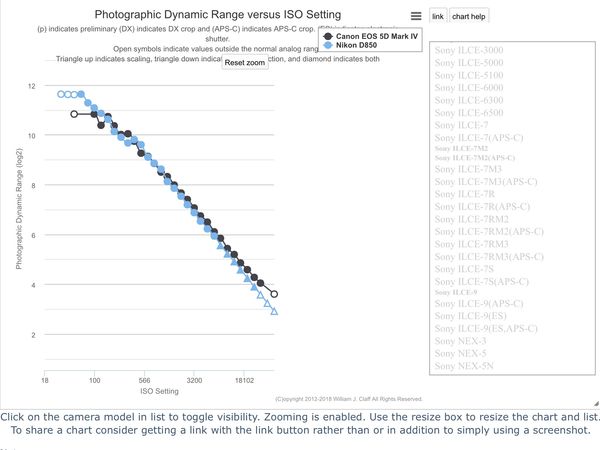Crop sensor camera verses full frame
May 15, 2018 16:04:08 #
srt101fan wrote:
"Old" noodle.... You got me on that one! 

No offense we all and I do too make mistakes we’ll all human have great day srt101fan.
May 15, 2018 16:32:46 #
jackpinoh
Loc: Kettering, OH 45419
drklrd wrote:
I use daily my D7200. I do plan to go full frame w... (show quote)
You have assumed that the crop factor applies to the area. It does not. Light collection per unit time is proportional to pixel area. The crop factor applies to the height and width of the frame. So a 1.5 crop yields a 2.25 reduction in area (1.5 x 1.5). If you crop the 36Mp sensor (1.5 crop), you get a sensor area of 16Mp, not 24Mp. So they did not "cut the edges off the full frame sensor" to get a 24Mp sensor and the 36Mp full frame sensor actually has larger pixels than the 24Mp crop sensor--which is why the full frame sensor has lower noise and better dynamic range at equal ISO with respect to the crop sensor.
So if you don't need more than 16Mp to print a 13" x 19" photo, and larger sensor pixels provide lower noise and higher dynamic range, why buy a 36Mp or 45Mp camera? (Of course I didn't figure this out until I'd already spent big bucks on a high Mp camera system.)
May 15, 2018 18:20:46 #
May 15, 2018 19:12:26 #
dsmeltz wrote:
This all depends on what you are trying to accompl... (show quote)
A friendly note. A crop frame does not give you more reach. It's a 35mm lens that projects to a 24mm sensor. If you crop the FF you will get the same apparent "reach". For example, Hold one hand away from you and form a circle. Without moving, make the circle smaller. You have cropped the image but your hand doesn't really move closer in. However, there are benefits to a "cropped" frame. I own both. And then there is mirrorless...
May 15, 2018 19:32:11 #
I use both and everything you have said is correct plus FF lenses are larger, heavier and much more expensive. My side by side test have revealed that there is no visible difference in image quality if you shoot at low ISO and reduce the FF images to the same size.
May 15, 2018 19:49:26 #
amfoto1 wrote:
Okay, I've got to defend Canon on this, once again... (show quote)
You don't need to defend Canon. But Canon needs to change their corporate philosophy of half-baked, drip, drip improvements. It was this disrespect for Canon's loyal users that led me to look at Sony mirrorless after forty years being a loyal pro Canon user. . Once I tried them,I switched to Sony FF mirrorless in January 2017, and have never looked back. Sorry but most experts agree Canon has been lacking in dynamic range, at the top, for a while now. Canon has no cameras that can match the 15stops of dynamic range that a Nikon D850 or both Sony A7RIII and A7III have.
Granted all cameras have better dynamic range at their native or lowest ISO. But for pros this is important as we tend to underexpose the highlights and then bring back the shadows in post. This is better accomplished with the best of Nikon and Sony dynamic range. Canon has some catching up to do, but corporate-wise they think they can just continue to dominate in overall camera sales and not match the growing competition at the top.
Well Sony announced at their Kando event in California this week that now Sony is the new worldwide leader in fullframe camera sales, ahead of fullframe Canon and fullframe Nikon sales. Times are a changing. That is why Canon and Nikon are spending millions developing true professional fullframe mirrorless cameras to compete. But sadly it looks like while Canon and Nikon may both announce their new systems at Photokina this fall, they are indicating that their new ff mirrorless cameras won't be in our hands until end of 2018 or early next year. With the fast pace of Sony improvements and releases, who knows where that moving target may be in early 2019 for Canon and Nikon to hit.
Cheers
May 15, 2018 20:12:10 #
Mike Holmes wrote:
If this has been discussed before I apologize but ... (show quote)
The chief difference between FF and crop is noise handling...there is about a 1 to 1.5 stop differential in noise level at same ISO. You can chart this at DxO. DR is slightly more with FF. FF will give you a bit more bokeh but this is also driven by lens quality and aperture used. DOF is slightly more with DX, at equivalent settings. IQ wise you will not notice a difference at reasonable ISO levels (on my D7200 I don't see appreciable noise until over 10k, so if I use auto ISO, I set max to 6400. You will not see a difference especially when printed, since that is largely determined by printer technology and media used.
FF will give you an edge is low light situations (church interiors, museums where flash is not allowed, e.g.). I recently bought a Sony Bravia 4K 55" - the IQ of pics I took recently is amazing on that screen. I have yet to do prints but I am selecting my best ones for printing.
Please note that cropping a FF image is not necessarily the same as using a crop sensor. If you DX crop a D750 you will get something like 11 or 12 MP. The D850 crop sensor mode will give you about 19+ MP- almost that of a D500 so you can say, in a sense, a D850 has a D500 built in.
BTW these topics will generate heated, passionate debates and opinions also: DSLR vs mirrorless, JPEG vs RAW, lens hood vs filter, auto ISO vs fixed ISO... I guess the film vs. digital debates ended a decade ago?

May 15, 2018 20:14:44 #
chrisg-optical wrote:
The chief difference between FF and crop is noise ... (show quote)
"BTW these topics will generate heated, passionate debates and opinions also: DSLR vs mirrorless, JPEG vs RAW, lens hood vs filter, auto ISO vs fixed ISO... I guess the film vs. digital debates ended a decade ago?"
Amen, lol
May 15, 2018 20:15:03 #
Without having read the previous seven pages, I'm going to assume from your question that you are not an advanced amateur, as a number of UHH members are. We're in the same category. I have both crop sensor and full sensor cameras. I started out with a D7000, 28-300mm, 10-24mm, and 50mm f1.8. To tell you the truth, that combination pretty well met my needs. I did buy a D800 and now also have a 24-70 and 70-200. Getting into full frame can be much more costly. I'd say for guys in our category....stick with crop sensor cameras.....until and when you KNOW that you need both the full frame camera and the better lenses. And don't be afraid to use full frame prime lenses, either, including some of the older ones.
May 15, 2018 20:22:42 #
jackpinoh
Loc: Kettering, OH 45419
chrisg-optical wrote:
BTW these topics will generate heated, passionate debates and opinions also: DSLR vs mirrorless, JPEG vs RAW, lens hood vs filter, auto ISO vs fixed ISO... I guess the film vs. digital debates ended a decade ago? 

I'm still upset about film putting so many oil painters out of business!
May 15, 2018 20:23:46 #
PHRubin wrote:
For the same number of Mega-pixels, the advantage of FF over APS-C is low light sensitivity, wider angles of view (for landscapes) with a given lens. The advantages of APS-C are smaller and lighter, better tele "reach", less expensive/more choices of lenses. With modern sensors, the low light capability of crop frame cameras is improving nicely.
But you must also consider that at least in the Canon line, and I suspect in Nikon as well, the highest quality/performance/rugged lenses are typically FF, so the lens cost and size/weight is not an advantage IF you want the highest performance glass. That is not to say that there is not the occasional EFS lens that is in the league with Canon “L series” lenses or Nikon’s “pro” lenses (as amfoto points out) BUT, in general, if you want the ultimate in IQ, weather sealing and especially speed, you’ll find that with FF lenses. There’s just no equivalent EFS lens to the classic 70-200 f2.8L IS MKII for instance, and I could reference a dozen more...
May 15, 2018 20:40:17 #
jackpinoh
Loc: Kettering, OH 45419
TriX wrote:
But you must also consider that at least in the Ca... (show quote)
I find unfortunate that Nikon, Canon, and Sony don't produce many high quality crop sensor lenses. However Olympus, Panasonic, and Fujifilm don't seem to have any trouble doing so.
May 15, 2018 20:43:17 #
gwilliams6 wrote:
You don't need to defend Canon. But Canon needs to... (show quote)
Well, different testing methods yield different results, but the source that I use doesn’t show any 35mm, Canon, Nikon or Sony close to 15 stops of DR. A Nikon D850 is a stop better than a Canon 5D4 BUT at base ISO, and once you’re at somewhere above ISO 200-300, you can’t see the difference. See below.

May 15, 2018 20:49:49 #
imagemeister wrote:
Another factor IMO, is in order to sell big prints to make FF pay for itself, you must be willing, able and afford to TRAVEL far and wide for landscape work. If you are independently wealthy, don't need or want to sell anything, this does not apply.
..
..
This is an individual decision, based on your assessment of the market for your specialty or specialties. Pro sources will prefer a FF image, but seem also willing to buy an APS image if it suits their needs. The image quality is good enough in either case, according to many of my pro friends and many market analyses.
FF provides additional body reliability, weather resistance, and low light performance, at a cost of 2x to 3x the price. Glass differential is even higher. If it's worth it to you, be blessed and go thine own way.
If not, you're my kind of amateur / semi pro.
Andy
May 15, 2018 20:54:15 #
jackpinoh wrote:
I find unfortunate that Nikon, Canon, and Sony don't produce many high quality crop sensor lenses. However Olympus, Panasonic, and Fujifilm don't seem to have any trouble doing so.
Can’t argue that - my Fuji crop lenses are first rate. And they are small and light, although not inexpensive for their faster glass.
If you want to reply, then register here. Registration is free and your account is created instantly, so you can post right away.







